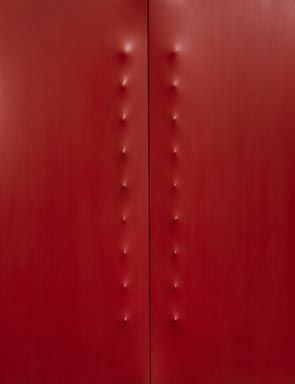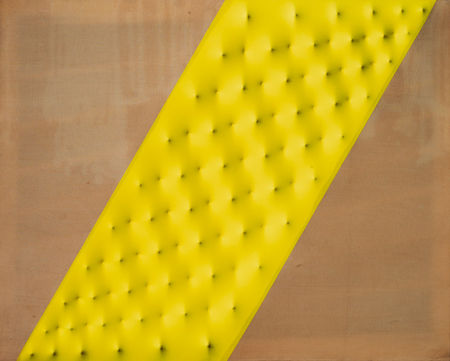"Enrico castellani. Rétrospective" @ galerie Tornabuoni Art
Enrico Castellani, Dyptique rouge, 1963-64 (detail), tempera sur toile, 157x152x20cm, courtesy galerie Tornabuoni Art.
Enrico Castellani, Dyptique rouge, 1963-64, tempera sur toile, 157x152x20cm, courtesy galerie Tornabuoni Art.
PARIS.- Du 14 octobre au 17 décembre 2011, la galerie Tornabuoni Art présente, à travers environ 45 oeuvres, une magistrale rétrospective consacrée à Enrico Castellani. Connu pour ses toiles monochromes en relief, Castellani (né en 1930) est une figure italienne majeure associée au mouvement ZERO qui, en renouvelant le langage de l’image et de la forme, a largement contribué au développement des avant-gardes en Europe dans les années 1950-1 960.
Ayant pris ses distances par rapport à l’expressivité du geste pictural, Enrico Castellani réalise des tableaux monochromes rendus dynamiques par l’action d’éléments perturbateurs des clous. Derrière une toile tendue sur un support de bois, Castellani dispose en effet des clous qui soulèvent ou enfoncent la toile pour créer un jeu d’ombres et de lumières. C’est sur l’une de ses oeuvres que s’ouvre la salle des Expérimentations italiennes, dans le nouvel accrochage des collections contemporaines du Centre Pompidou (niveau 4). Outre cette reconnaissance publique, Enrico Castellani séduit aussi les collectionneurs : ses oeuvres, très recherchées, atteignent parfois le million de dollars en salles de ventes aux enchères.
La toile comme une membrane vivante
C’est en 1959 que Castellani réalise sa première surface en relief, premier monochrome « extra-fléchi » qui sera suivi de multiples variations dans la répartition des éléments. Ce faisant, il inaugure avec la technique de la « répétition différente» sa poétique personnelle, choisissant soigneusement l’emplacement des creux et des bosses qui donnent du rythme à ses toiles. Cet automne, la galerie Tornabuoni Art présente notamment une oeuvre historique: E un Diptyque rouge de 1963. C.,
Son approche originale est considérée comme fondamentale pour l’histoire artistique du XXème siècle, non seulement en Italie mais également sur la scène internationale. Casteltani a notamment influencé Donald Judd qui voyait en lui le père du minimalisme.
A l’occasion de cette exposition consacrée à Castellani, qui est sa première grande rétrospective en galerie, Tornabuoni Art édite un catalogue très complet sur l’artiste, préfacé par Bernard Blistène.
Et du 20 au 23 octobre, la galerie Tornabuoni Art participera à la FlAC avec une sélection d’artistes incontournables pour le marché de l’art international.
La galerie Tornabuoni Art a inauguré son espace avenue Matignon à Paris le 1er octobre 2009 avec une exposition de Luclo Fontana qui a remporté un vif succès, suivie par une rétrospective sur Alighiero Boetti au printemps 2010. Plus de 4,000 visiteurs ont répondu présents. Spécialisée principalement dans l’art italien de la deuxième moitié du XXème siècle, la galerie organise alternativement d’ importantes rétrospectives d ‘artistes majeurs italiens d ‘après- guerre et des expositions de groupes d’artistes internationaux fondamentaux. Tornabuoni Art ‘Ç I présente ainsi des oeuvres significatives des principaux auteurs du “Novecento” italien De Chirico, Morandi, Balla, Severini, et des avantgardistes internationaux du XXèrne siècle : Picasso, Mirà, Kandinsky, Hartung, Poliakoff, Dubuffet, Lani, Matta, Christo, Warhol, Wesselmann, Basquiat.
Les expositions à Paris sont réalisées par Micliele Casamonti et Gaïa Donzet en collaboration avec Tornabuoni Arte à Florence. qui fut la première galerie créée en 1981 par Roberto Casamonti, dans la rue qui a donné son nom à la galerie. Par la suite Tornabuoni Art a ouvert des espaces à Milan en 1995, à Portofino en 2001, Forte Dei Marmi en 2004, et enfin Paris en 2009 pour être au plus proche de ses clients et répondre au mieux aux attentes de son audience de collectionneurs internationaux.
Parallèlement à ses activités liées à l’art moderne, Roberto Casamonti n monté en 2006 une galerie d’antiquités. incluant du mobilier, des peintures, sculptures, et des fonds d’or du XIV et XVème siècle, son autre passion: “l’Arte non ha tempo” (l’Art n’a pas dc temps).
After distancing himself from the expressiveness of pictorial portrayal, Enrico Castellani proceeded to produce monochromatic pieces rendered dynamic by the action of disturbing elements: nails. Indeed, behind a canvas stretched over a wood frame, Castellani places nails that raise or lower the canvas and so create an interplay of light and shadow. The Italian Experimentation room opens with one of his works in the new contemporary collections area of the Pompidou Centre (level 4). In addition to this public recognition, Enrico Castellani also attracts collectors: his highly sought-after works sometimes go for as much as one million dollars on the auction block.
Canvas as a living membrane
In 1959 Castellani made his first embossed surface, his first "extra-flexed" monochrome, which would be followed by multiple variations in the distribution of the various components. In so doing, he inaugurated his own personal poetics with the technique of "differing repetition", by carefully choosing the placement of the recesses and reliefs that give rhythm to his canvasses. This autumn, the Tornabuoni Art gallery will present a historical work: a Red Diptych from 1963.
His original approach is considered fundamental for the art history of the 20th century, not only in Italy, but also on the international scene; In particular, Castellani influenced Donald Judd, who saw him as the father of minimalism.
For the occasion of this Castellani exhibition, which is his first major retrospective in a gallery, Tornabuoni Art is publishing a very complete catalogue on the artist with a preface by Bernard Blistène.
And from 20 to 23 October, Tornabuoni Art will participate in the FIAC with a selection of crucial artists for the international art market.
About the gallery
The Tornabuoni Art gallery inaugurated its space on Avenue Matignon in Paris on 1 October 2009 with an exhibition of Lucio Fontana, which was met with keen interest, followed by a retrospective on Alighiero Boetti in the spring of 2010. More than 4,000 visitors turned out.
Specializing primarily in Italian art from the second half of the 20th century, the gallery organizes important retrospectives on major post-war Italian artists and exhibitions of groups of fundamental international artists. Tornabuoni Art thus presents significant works by the primary authors of the Italian "Novecento": De Chirico, Morandi, Balla, Severini, and international avant-garde artists of the 20th century: Picasso, Mirò, Kandinsky, Hartung, Poliakoff, Dubuffet, Lam, Matta, Christo, Warhol, Wesselmann, Basquiat…
The Paris exhibitions are handled by Michele Casamonti and Gaïa Donzet in collaboration with Tornabuoni Arte in Florence, which was the first gallery created in 1981 by Roberto Casamonti in the street that is its namesake. Since then, Tornabuoni Art has opened galleries in Milan in 1995, Portofino in 2001, Forte Dei Marmi in 2004, and lastly Paris in 2009 to be closer to its clients and optimally meet the expectations of its audience of international collectors.
Alongside his modern art activities, in 2006 Roberto Casamonti opened an antique gallery including furniture, paintings, sculptures, and gold pieces from the 14th and 15th centuries, his other passion: ''l'Arte non ha tempo'' (Art is timeless).

/https%3A%2F%2Fprofilepics.canalblog.com%2Fprofilepics%2F1%2F0%2F100183.jpg)
/https%3A%2F%2Fstorage.canalblog.com%2F03%2F02%2F119589%2F96711876_o.jpg)
/https%3A%2F%2Fstorage.canalblog.com%2F11%2F31%2F119589%2F94773502_o.jpg)
/https%3A%2F%2Fstorage.canalblog.com%2F20%2F83%2F119589%2F94772815_o.jpg)
/https%3A%2F%2Fstorage.canalblog.com%2F26%2F72%2F119589%2F75604929_o.jpg)
/https%3A%2F%2Fstorage.canalblog.com%2F59%2F60%2F119589%2F26458628_o.jpg)






/http%3A%2F%2Fstorage.canalblog.com%2F49%2F79%2F119589%2F96012839_o.jpg)
/image%2F1371349%2F20240417%2Fob_9708e8_telechargement.jpg)
/image%2F1371349%2F20240417%2Fob_91ce89_x5173-online-caravaggio-the-martyrdom.jpg)
/image%2F1371349%2F20240417%2Fob_d3a4e9_437713486-1653094185460594-71860440393.jpg)